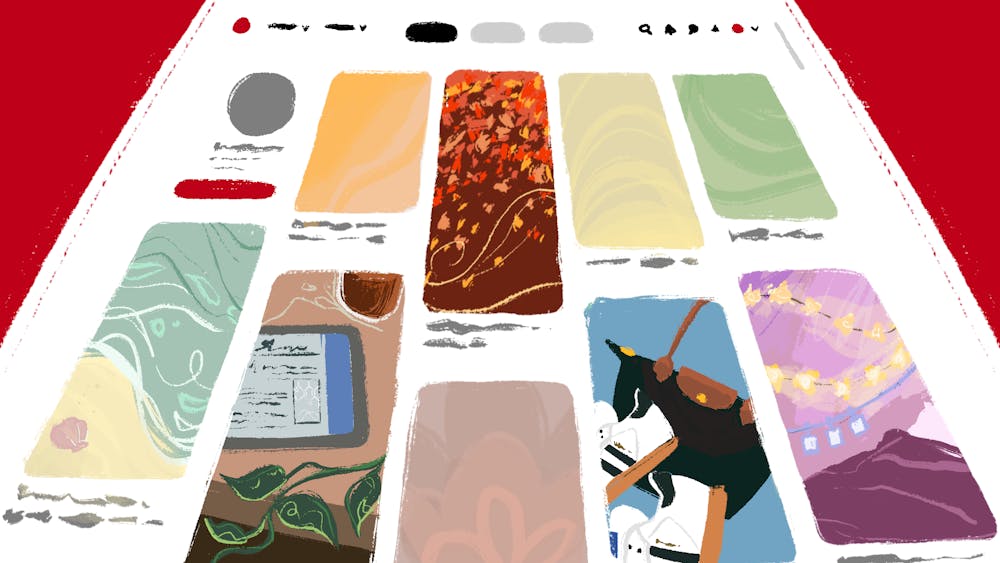It’s August before college move–in. This year you want your room to look perfect—with all the band posters, LED fairy lights, and colorful shag rugs you've dreamed of. Your new room will be far different from last year when you constantly felt embarrassed for not having all the dorm essentials. You turn to Pinterest to look for some inspiration in your “dream dorm” board, and, suddenly, you notice one hidden board among the esteemed collection you’ve spent so much creating. A small tear dribbles down your cheek as you realize how much you need to spend on useless minimalistic decor on Dormify instead of just taping your disposable film photos to the walls.
Although Pinterest was not intended to be a classic social media platform in the common sense, it has become another driving force of pursuing dictated aesthetics, keeping up with ever–changing trends and hiding true interests. But how exactly does it make us choose performativity over genuine passions?
It’s understandable that we often strive for the ideal picture—whether it be a bedroom, outfit, or daily routine. Anyone who’s ever taken PSYC 1010 knows that we look for similarities with others, especially our peers (so–called “herd mentality”). The problem arises when forms of media that were initially created to support our individuality and personal interest transform into unifying mechanisms.
Let’s think about TikTok. Are you brat or demure? Certainly, at least once, you’ve looked both of these aesthetics up online. And at least one of your peers went to the SWEAT concert on Sept. 25. Whether you like it or not, you are very likely to notice neon green images as a suggestion to add to your 2024 vision board. This algorithm is relevant not only to the brat case, but also to any major trends over the past several years: VSCO, alternative, Y2K, Barbie, you get the gist. When you make a Pinterest profile, the app immediately merges you into “suggested interests” that usually include mass pop culture trends, instead of entailing specific niche hobbies.
This situation has worsened with the constant shifting of aesthetics. It becomes evident from Pinterest’s trends analytics how quickly up–to–date tendencies change—annual increases in a particular search’s popularity, like “farm life dress to impress" and "dewy summer makeup,” can achieve more than 10,000%. Apparently, this carousel–like model and herd–promoting algorithms can make us invest too much time and energy in closely investigating trends and curating our online and offline spaces to be able to keep up with our peers.
You may say that this problem is common to social media in general, but Pinterest’s case is unique, as the platform facilitates “flow production” of boards and posts—à la factory assembly lines. Since we don’t use Pinterest to differentiate ourselves or gain loyal followers, we only strive to maintain a decent appearance. This results in pinning pages of cappuccinos with delicate iPad notes in the background, fall landscapes, and Pilates practices. This creates a wider disconnect between real life and its idealized, showcased version online and offline, when instead of wearing your comfortable sneakers you reach for the cherry–colored ballet flats.
Recall your average walk on Locust. You see tons of Adidas Sambas, Longchamp bags, and gray cardigans. All these trends may originate from Instagram, but their accumulation and bloom occurred thanks to Pinterest. With thousands of people recreating similar “OOTD” pins and millions looking at them on a unified search platform, Pinterest fosters the concealment of our real interests.
The dichotomy between public persona and private hobbies exists not only on the level of fashion and accessories, but also on the level of lifestyle as well. With their own beneficent consequences, Pinterest exposed us to at–home HIIT workouts and daily journaling sessions, encouraging many users to opt for healthier habits.
Still, we see the opposite side of the Pinterest coin when our feeds recommend specific TV shows, music, events, and travel destinations. Such peer pressure can be stressful for those who do not want to or who struggle to keep up with the latest changes in trends. This not only negatively affects self–identity and creates missed opportunities of connecting with real like–minded peers, but can also pose significant financial constraints. So, here we deal with another case of unintended consequences from a good initiative.
Still, at the end of the day, we all love Pinterest. We find solace in gathering inspiration for our bedrooms and wardrobes. Nonetheless, we should try to use it without succumbing to peer pressure, rather as a media to look for a whole diversity of interests and initiatives. Your hidden board can be a hidden gem for someone who may not be looking not for yet another minimalist dorm, but instead for a chaotic, cozy, home–like space. Suddenly, the semester is beginning, and the disposable pictures on your wall are the perfect decor.

